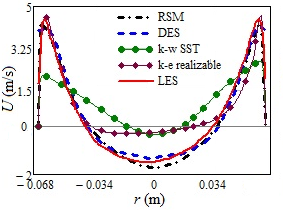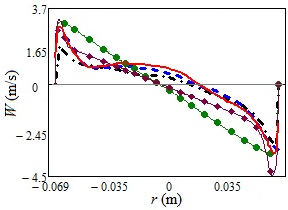Evaluation AC6-15
Vortex ropes in draft tube of a laboratory Kaplan hydro turbine at low load
Application Area 6: Turbomachinery Internal Flow
Application Challenge AC6-15
Evaluation
COMPARISON OF TEST DATA AND CFD
We present first a summary of the performance of various URANS models on a typical RANS grid of 2M nodes and compare with the LES on 6M and DES on 2M grid for the low part-load of ≈ 0.4. All RANS calculations were performed in unsteady mode. The time-averaged streamline patterns and colour contours of the fields of the vertical velocity in Fig. 7 clearly show that the RSM, DES and LES all give very similar results; whereas the linear eddy viscosity models (LEVM) show quite a different and, as shown below, erroneous flow pattern. This is substantiated by a quantitative comparison with experiments of the profiles of the axial and tangential velocity components and the rms of their fluctuations at the 3 mm cross-section, Figs 8 and 9. It is noted that the LES on the 6M grid reproduced best the experimental data, but the DES and RSM (both using the coarse, 2M grid) show also good agreement with the measurements. Since the DES employs LES in the flow bulk, it is likely that the LES would also reproduce well the helical vortex pattern on the 2M grid provided the near-wall region (with the average y+1,aver = 9.0) is treated by some wall-function, or using a near-wall RANS approach as practiced by DES. This option was not tested here since, as already stated above, the near-wall resolution on the 2M grid is far too coarse for a proper LES. In contrast, both EVMs notably failed, as shown by typical (unphysical) solid-body profiles of the tangential velocity and a wrong recirculation pattern. Moreover, the k-ε realizable and k-ω SST, LEVMs on the 2M grid could not maintain the unsteadiness, most probably due to excessive numerical diffusion that suppressed the natural instabilities, and resulted in stationary solutions failing to capture the twin rope precessing structures.
| k-ε realis. (2M) | RSM (2M) | DES (2M) | LES (6M) |

|

|

|

|

| |||
| Figure 7: Time-averaged vertical velocity field and streamlines in vertical symmetry plane. The colour denotes the velocity magnitude. | |||
| (a) | (b) |
 |

|
| Figure 8: Axial (a) and tangential (b) velocity component in the draft tube diffusor at 3 mm behind the cone, obtained by different turbulence models. Grids: (U) RANS and DES 2M, LES 6M. | |
The same prediction quality and trends are observed in the cross section located at 53 mm below the runner
(Fig.7, red line) as shown by the velocity profiles and their fluctuations in
Figs. 10 and 11. Due to the lack of experimental data at this cross-section we cannot verify the computational data. However, it can be seen that just as in
Figs. 8 and 9 for the cross-section of 3 mm, the RSM and DES models are in good agreement with the reference LES results, whereas the results obtained by the two linear EVM models differ significantly showing the same shortcomings as in
Figs. 8 and 9.
However, using a finer grid of 6 M notably improved the performance of the two LEVMs. This time the URANS computations maintained the unsteadiness throughout the whole computations and captured better the characteristic time-averaged streamline pattern and the associated mean velocity profiles, as illustrated in Fig. 12 (here shown for the k-ω SST model), comparable to RSM and DES on 2M in Fig. 7.
As seen in Fig. 12, the URANS (k-ω SST model) computations on 2M grid resulted in a steady solution which differs from those of LES (but also from the k-ε realizable model, Fig. 8), whereas the same model on the 6M grid produced unsteady solutions, which after averaging, come much closer to the reference LES pattern.

|
| Figure 12: Time-averaged vertical velocity field and streamlines from (U) RANS EVMs compared with LES. |
Figure 13 confirms the above by comparison of the mean velocity and turbulent kinetic energy with the measurements. A striking consequence of the failure of LEVMs on the coarser grid is seen in the profiles of the total (resolved plus modelled) kinetic energy (Fig. 13 bottom left). The failing to retain the unsteadiness and to resolve the fluctuating velocities led to compensation the resolved kinetic energy by an erroneous modeled turbulent stress and kinetic energy field.
Vortical ropes and pressure pulsations
Precession of the vortex core occurs under partial load (in the turbine model here considered at a discharge rate of 0.2 – 0.85 of the optimal value), where the flow has a considerable residual swirl. Vortex breakdown in such a flow leads to the formation of a recirculation zone (see Fig. 12) at the flow axis and the rotation of the corkscrew vortex rope (often visible by local evaporation or / and dissolved air) around it. Figure 14 shows selected snapshots of the typical vortex ropes and their structures after the runner, captured by different models and compared with experimental visualization of Skripkin, Tsoy, Shtork, & Hanjalić, (2016). The ropes are identified by the instantaneous isosurfaces of a selected value of pressure.
Contributed by: A. Minakov [1,2], D. Platonov [1,2], I. Litvinov [2], S. Shtork [2], K. Hanjalić [3] —
[1] Institute of Thermophysics SB RAS, Novosibirsk, Russia,
[2] Siberian Federal University, Krasnoyarsk, Russia,
[3] Delft University of Technology, Chem. Eng. Dept., Holland.
© copyright ERCOFTAC 2019
















